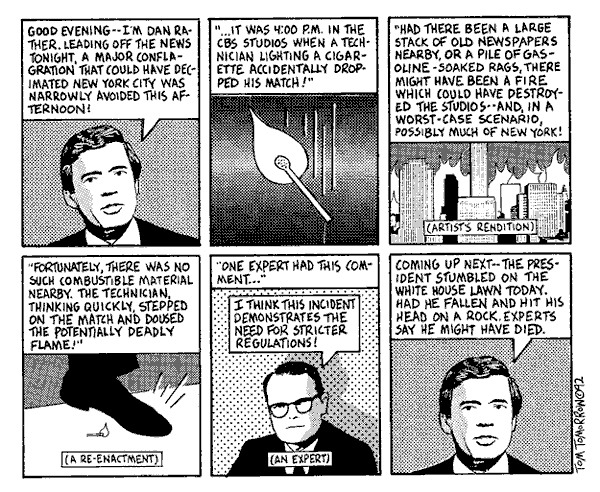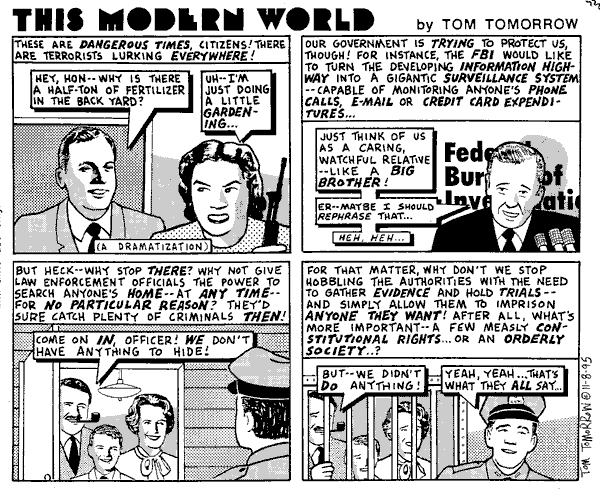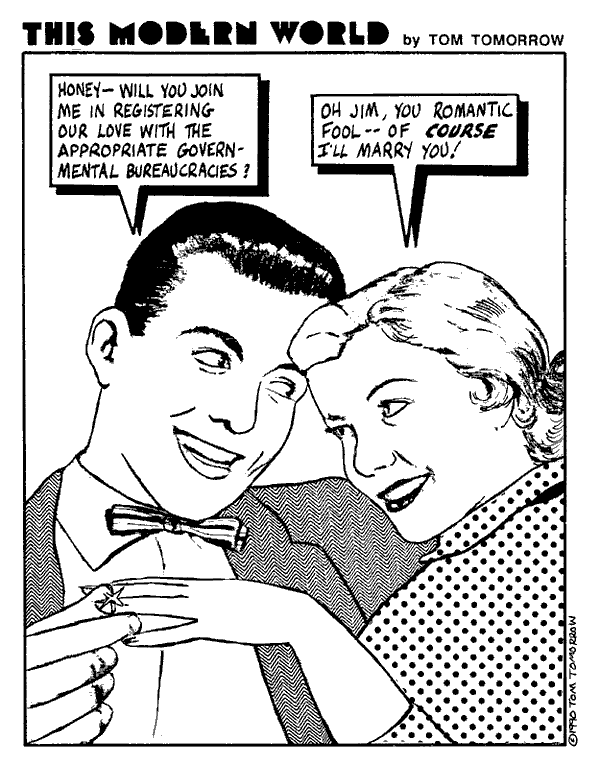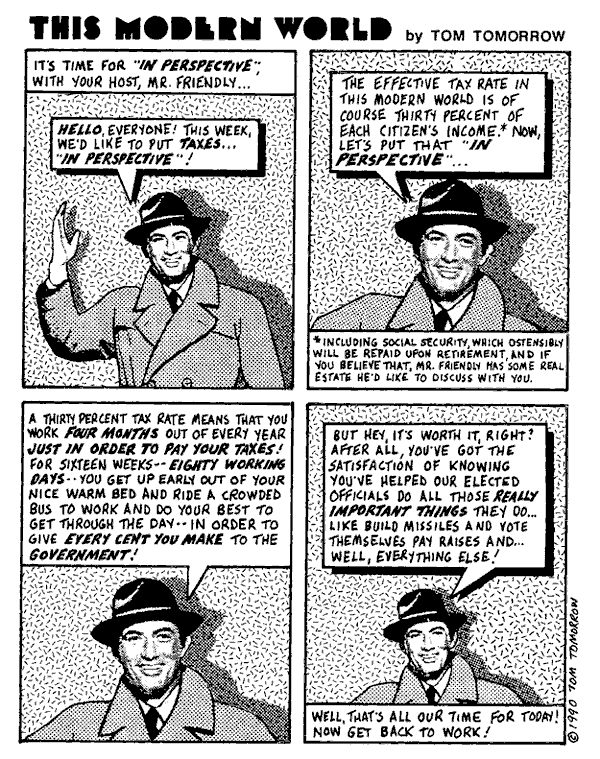I spent most of this morning reading through The American Prospect‘s recent insert on the politics of mental illness
. With only two exceptions, the articles generally range from dull political hack-work to unsettling exercises in missing the point to disturbing demands for massive, federally-driven centralization and escalation in the size, scope, power, and invasiveness of State-backed institutional psychiatry, its regimentation of everyday life, and its access to fresh captives to call patients.
(The two exceptions were a first-person account by a woman who had been diagnosed as schizophrenic
, which is mainly about how you should be nice to people who have been labeled mentally ill
and treat them like human beings worthy of your concern; and another article on treatment alternatives, which spends about half of the article talking about Clubhouse
model centers, which were founded by former inmates of the psychoprison system, which are strictly voluntary, and which are organized around principles of participation and equality among the crazy
owner-residents and their hired helpers.)
I was originally referred to the feature by an Utne online feature focusing on the articles that had most to do with the intersection between institutional psychiatry and the prison system; the point of that feature (and the articles it referenced) was to call for more diversion programs
and mental health courts
. If you’re not familiar with the concepts, the way a diversion program
works is this: somebody, usually somebody poor, gets busted by the cops for doing something that endangered nobody, or at most endangered herself, like consensual drug use, or prostitution, or just acting kind of funny in public, but which other, usually more privileged, people in her society find distasteful, contemptible, or trashy. She is forcibly restrained and locked in a cage for this victimless crime.
Some professional busybody, usually a shrink or a government social worker, is sent by to declare that the poor thing can’t help herself, and that, rather than being locked in a cage for even longer, she should have a judge order her into a program that will teach her what a worthless shit she has been all her life, and how she needs to submit to the help
being forced on her by court order so that she can live a worthwhile and healthy life, where healthy
is defined as holding a low-wage job in a legal capitalist workplace, paying a landlord regularly for an apartment which you keep reasonably neat and tidy, and generally living up to a lowered set of social expectations and not acting in ways which your neighbors find obnoxious. It is an overt tool of normalization through the use of force and the threat of even more violent measures against a captive victim-beneficiary (usually, the threat of throwing you back into a hellhole jail or prison; if you have children, this is often accompanied with the threat of abducting your children and putting them into the hellhole foster care system). This is then passed off as an act of liberal humanitarianism and wise statesmanship by self-congratulatory government legislators, judges and bureaucrats. These programs typically make use of special court systems in which defendants are stripped of normal procedural rights on the excuse of a non-adversarial process supposedly being carried out for the good of the defendant’s soul — like a mental health court
, which is a special court of inquisition, in which defendants have no right to a trial by jury, no due process rights against self-incrimination, and in which it is expected that the defendant’s legal representative
will be collaborating with the judge, with or without the knowledge of her client,
to come up with invasive and controlling treatment
regimens of captivity in institutions, submission to all kinds of invasive surveillance by doctors and government hirelings, and, more or less invariably, some form or another of forced drugging, with the threat of prison used as a back-up plan if the defendant refuses to comply. Once again, this reversion to the standards of jurisprudence popular in the early modern trials for heresy and witchcraft, usually inflicted only to control the behavior of non-violent offenders,
i.e., as an act of aggression against those who have done nothing to invade anyone else’s rights, is passed off as both pragmatic cost-control and humanitarian concern for its victims.
Of course, it’s generally true that diversion programs
and mental health courts
and the like are in some ways notably better than what they replace — that is, the torture and confinement of harmless people in government jails and prisons. Being whacked on the head with a hammer is better than being shot in the head by a shotgun; but if someone came up to me and said I ought to kill you for what you’ve done, but, you know, I feel sorry for you, so I’m going to divert you into the hammer-whacking instead,
I think the proper response is, Well, don’t do me any favors.
The real solution is for the State to stop violently persecuting people who aren’t invading anyone else’s rights, and for shrinks and social workers and all the rest of the crew to confine themselves to offering help to those who are looking for help, rather than having a dangerous street gang grab people off the street for their own particular use.
But of course you won’t see that, or anything like that, unless, and until, the majority and the politico-therapeutic power elite no longer agree amongst themselves more or less unanimously on the propriety of treating anyone who can be labeled crazy
as something less than a fellow individual human being, with her own thoughts, desires, goals, dreams, and reasons for doing the things that she does. But of course if you insist on respecting a crazy
person’s inner life, or on taking her seriously as a human being with thoughts and reasons of her own, which, even if you disagree with those thoughts and reasons, can and ought to be understood and engaged with, rather than fixed, then you will be immediately shouted down by a hooting horde of self-appointed experts
and advocates
who will insist that you are romanticizing a serious illness,
and who will make ridiculous pronouncements like this comment in response to an article written after David Foster Wallace killed himself:
It is nothing more than dangerous romanticism to think that we can logic
our way out of mental illness.
Note: Nobody had made this claim anywhere in the article or in the previous comments. Self-appointed mental health advocates
very often try to establish themselves as caring
by throwing out these scattershot accusations that somebody, somewhere is advocating a callous and trivializing just-suck-it-up
sort of response to serious emotional suffering, regardless of whether or not anyone has actually said anything of the sort. –R.G.
As a culture, we need to start accepting that the gifts
of the mentally ill — in this case, I’m told, his brilliance as a writer and thinker — often come with dangerous deficits.
But thinking and writing wasn’t enough to cure this man’s illness, just like a bottle of Wild Turkey wasn’t enough, either.
Don’t think you can make sense
out of youngish man hanging himself. There is no sense in it. It is mental illness. Untreated mental illness, that had probably been overly glorified as profundity.
— Gina Pera, in re: David Foster Wallace (1962–2008)
The problem is that this is utter nonsense. We’re not talking about someone who, oops, managed to hang himself by accident. He had his own reasons for doing so, and everyone I know, either personally or through writing, who killed themselves or tried to kill themselves, had some fairly specific reasons for wanting to die. Often they are willing to tell you what those reasons are if you ask, or even if you did not ask. These are acts that are invariably part of a larger life story, and they are always done for perfectly explicable reasons that are plausibly connected with what somebody is going through in their life.
Those reasons, once explained, may be bad reasons; they may even be bizarre reasons. But it is completely irresponsible, and chillingly dehumanizing to the people whose lives you claim to care about, to talk as if those reasons just didn’t exist, even when it’s been explained to you what they were, or as if they can simply be waved off just so many meaningless chirps coming from a broken brain,
rather than the results of a serious and impassioned process of reasoning and deliberation. Bad reasons need to be engaged with, not fixed,
and the fact that you happen not to agree with them doesn’t make them any less real, or any less important in understanding why people do what they do, or any less vital to understanding the best way to help them if you really care about their lives.
One of the important points that Peter Breggin makes repeatedly in Toxic Psychiatry is the way in which official psychiatric ideology about mental illness
literally dehumanizes people labeled crazy,
and provides an excuse for laziness and aggressive disregard for the integrity of mental patients’
lives. The problem is almost never that what somebody being labeled crazy
does or says cannot be understood; it’s that the rest of us fail, or actively refuse to understand it, and we rationalize our failure and blame it on the person herself:
Biological psychiatrists–nowadays most psychiatrists–are fond of saying You can’t talk to a disease.
The communication of so-called schizophrenics makes no sense at all to these doctors who want to control symptoms,
such as hallucinations and delusions, with drugs, electroshock, and incarceration.
The idea that these extremes of irrationality are due to a disease is inseparable from the survival of psychiatry as a profession. If schizophrenia is not a disease, psychiatry wold have little justification for using its more devastating treatments. Lobotomy, electroshock, and all of the more potent drugs, including neuroleptics and even lithium, were developed at the expense of locked-up people, most of whom were labeled schizophrenic. The search for biochemical and genetic causes keeps psychiatrists, as medical doctors, in the forefront of well-funded research in the field. The notion that patients have sick brains
justifies psychiatry’s unique power to treat them against their will. It also bolsters psychiatry’s claim to the top of the mental health hierarchy. In short, if irrationality isn’t biological, then psychiatry loses much of its rationale for existence as a medical specialty.
— Peter Breggin (1991). Toxic Psychiatry: Why Therapy, Empathy, and Love Must Replace the Drugs, Electroshock, and Biochemical Theories of the New Psychiatry.
New York: St. Martin’s Press. 23. #
He stresses that this is true of so-called affective
disorders just as it is true of so-called schizophrenia.
When we cannot readily identify with the depressed person’s plight, more often it is due to our own lack of understanding than to the obscurity of the causes.
— Peter Breggin (1991). Toxic Psychiatry: Why Therapy, Empathy, and Love Must Replace the Drugs, Electroshock, and Biochemical Theories of the New Psychiatry.
New York: St. Martin’s Press. 126.
And, once again, on schizophrenia:
On July 27, 1986, 60 Minutes
produced a show entitled Schizophrenia. It was based on biopsychiatric theories, and one of their experts declared, We know it’s a brain disease now. It’s like multiple sclerosis, Alzheimer’s disease.
On the show, vignettes of patients were presented to impress the audience with the bizarre quality of their communications, and hence the absurdity of any psychological meaning or underpinning to their disease.
The first 60 Minutes
patient, Brugo, bolsters his identity with spirituality, as well as religion, and declares that he’s not extinct
: And I’m Croatian Hebrew, which is Adam and Eve’s kin. And I have been Croatian Hebrew for centuries and cent–upon centuries. And I’m a Homo-erectus man, and I’m also part Neanderthal, and I mean to keep that heritage, ’cause I’m not extinct.
Packed into these few remarks is symbolism about his desperate need for personal value and dignity, his identification with religion and humanity, and perhaps his awareness of primitive impulses stirring inside himself, as well as his fear of personal extinction. Here is more than enough material to stimulate anyone’s desire to communicate with him.
The second patient, Jim, is dismissed by the interviewer because he is convinced he was shot to death when he was a baby.
Yet his brief remarks seem like a metaphor for child sexual abuse by a male: I had my head blown off with a shotgun when I was two years old. And–and before that, things happened in my crib. I remember all these things and stuff, but I just remember, you know. I remember all this stuff.
A therapist with experience in listening to people immediately would wonder about what lies behind Jim’s direct hints about terrifying memories from early childhood, not to mention the symbolism of the crib in relation to his present trapped condition. More than one patient of mine has begun with just such anguished fragments of memory before discovering the agony of his or her abusive childhood and its relationship to current entrapments.
. . . The patients’ quotes were selected by 60 Minutes
to demonstrate that so-called schizophrenia is a biochemical disease rather than a crisis of thinking, feeling and meaning. Yet people with real brain disease–such as Alzheimer’s, stroke, or a tumor–don’t talk symbolically like these people do.
Instead of metaphors laced with meaning, brain-damaged people typically display memory difficulties as the first sign that their mind isn’t working as well as it once did. They have trouble recalling recently learned things, like names, faces, telephone numbers, or lists. Later they may get confused and disoriented as they display what is called an organic brain syndrome. In fact–and this is very important–advanced degrees of brain disease render the individual unable to think in such abstract or metaphorical terms. The thought processes that get labeled schizophrenia require higher mental function and therefore a relatively intact brain. No matter how bizarre the ideas may seem, they necessitate symbolic and often abstract thinking. That’s why lobotomy works
: the damage to the higher mental centers smashes the capacity to express existential pain and anguish. As we’ll find out, it’s also why the most potent psychiatric drugs and shock treatment have their effect.
How are we to approach people who get labeled schizophrenic? Do we think of them as troubled humans struggling in a self-defeating style with profound psychological and spiritual issues, usually involving their basic worth or identity? Or do we view them as if they are afflicted with physical diseases, like multiple sclerosis and Alzheimer’s disease, in which their feelings, thoughts, anguishes, and aspirations play no role? Do we try to understand them, or do we try to physically fix them? . . . If we are beings rather than devices, then our most severe emotional and spiritual crises originate within ourselves, our families, and our society. Our crises can be understood as conflicts or confusion about our identities, values, and aspirations rather than as biological aberrations. And as self-determining human beings, we can work toward overcoming those feelings of helplessness generated by our past spiritual and social defeats.
By contrast, the typical modern psychiatrist–by disposition, training, and experience–is wholly unprepared to understand anyone’s psycho-spiritual crisis. With drugs and shock treatment, the psychiatrist instead attacks the subjective experience of the person and blunts or destroys the very capacity to be sensitive and aware. No wonder the treatment of mental patients often looks more like a war against them. It often is.
— Peter Breggin (1991). Toxic Psychiatry: Why Therapy, Empathy, and Love Must Replace the Drugs, Electroshock, and Biochemical Theories of the New Psychiatry.
New York: St. Martin’s Press. 23–26.
See also:






